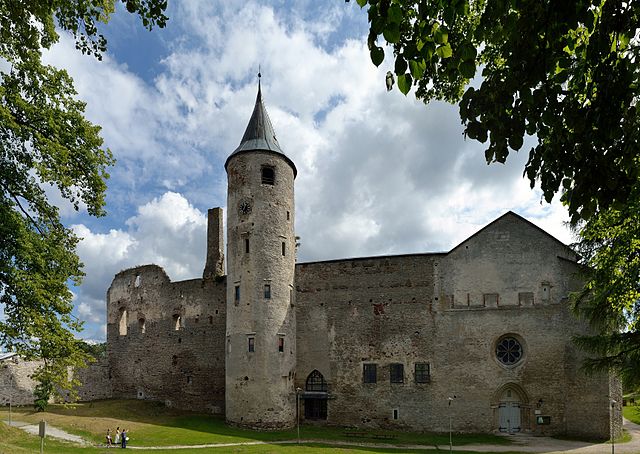Loading AI tools
Semi-independent Roman Catholic prince-bishopric From Wikipedia, the free encyclopedia
The Bishopric of Ösel–Wiek (Estonian: Saare-Lääne piiskopkond; German: Bistum Ösel–Wiek; Low German: Bisdom Ösel–Wiek; contemporary Latin: Ecclesia Osiliensis) was a Roman Catholic diocese and a semi-independent prince-bishopric — part of Terra Mariana (Old Livonia) in the Holy Roman Empire. The bishopric covered what are now Saare, Hiiu, Lääne counties and the western part of Pärnu county of Estonia.
This article includes a list of general references, but it lacks sufficient corresponding inline citations. (April 2022) |
Bishopric of Ösel–Wiek | |||||||||||||
|---|---|---|---|---|---|---|---|---|---|---|---|---|---|
| 1228–1560 | |||||||||||||
 The Bishopric of Ösel–Wiek, shown (red, upper left, across the Estonian mainland and the islands of Dagö (Hiiumaa) and Ösel (Saaremaa)) within the Livonian Confederation, 1260 | |||||||||||||
| Status | Prince-Bishopric of Terra Mariana | ||||||||||||
| Capital | Leal (Lihula) Perona (Vana-Pärnu) Hapsal (Haapsalu) Arensburg (Kuressaare) | ||||||||||||
| Common languages | Low German, Estonian | ||||||||||||
| Religion | Roman Catholic | ||||||||||||
| Government | Prince-Bishopric | ||||||||||||
| Prince-Bishop | |||||||||||||
• 1228–1229 | Gottfried | ||||||||||||
• 1542–1560 | Johannes V von Münchhausen | ||||||||||||
| Historical era | Middle Ages | ||||||||||||
• Established | 1 October 1228 | ||||||||||||
• Sold to Denmark | 1560 | ||||||||||||
| |||||||||||||
| Today part of | Estonia | ||||||||||||


The bishopric was created on 1 October 1228 as a Latin rite, and initially possibly exempt, diocese by papal legate William of Modena and simultaneously as a state of Holy Roman Empire—making it a prince-bishopric—by Henry, King of the Romans (1220-1242; not Emperor). Due to the repeated shift of the seat of the bishops, it was also successively known as bishopric of Leal (Lihula) from 1234, Perona (Vana-Pärnu) from 1251, Hapsal (Haapsalu) Castle from 1279, and the seat shifted (alone) to the castle of Arensburg (Kuressaare) on the island of Ösel (Saaremaa); the cathedral and cathedral chapter (canons) remained in Hapsal. It was a suffragan diocese in the ecclesiastical province of the Metropolitan Archbishopric of Riga from 1253.
One of the five members of the Livonian Confederation, the state was administratively divided into two bailiwicks (Latin advocaciae, German Vogteien). The bishop was also the lord of the Teutonic Order over its fiefs on the bishopric's territory. From 1241 until 1343, Ösel (Saaremaa) Island was an autonomous part of Ösel-Wiek prince-bishopric (autonomy renewed 27 August 1255).
The principality ceased to exist in 1560 when its last prince-bishop, Johannes V von Münchhausen, sold it to Denmark, which vested executive power in royally appointed Governors (styled Lensmænd to 1654, then Statthalter). King Frederick II of Denmark's brother Magnus of Livonia, Duke of Holstein, obtained it as an appanage on 15 April 1560 and was elected bishop on 13 May 1560; the Danish dynasty being Lutheran, he abolished the diocese and assumed the secular feudal style Lord of Ösel (Stieffte Ozel und Wieck Herr) on 20 March 1567.
Denmark ceded Wiek (Lääne County) to the Polish–Lithuanian Commonwealth in exchange for parts of Ösel belonging to the Livonian Order. Later Ösel became a Danish possession.
Seamless Wikipedia browsing. On steroids.
Every time you click a link to Wikipedia, Wiktionary or Wikiquote in your browser's search results, it will show the modern Wikiwand interface.
Wikiwand extension is a five stars, simple, with minimum permission required to keep your browsing private, safe and transparent.